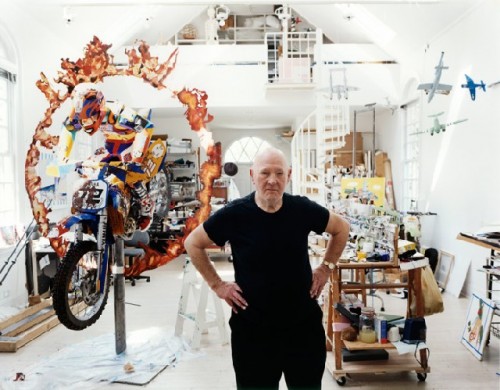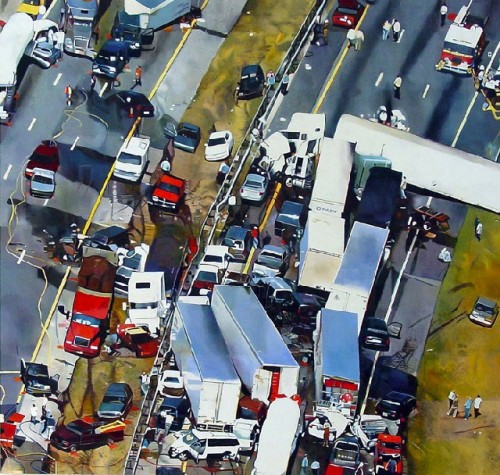Malcolm Morley at Britain's Ashmolean Museum
Beyond Photo Realism
By: Paul Black - Dec 03, 2013
Malcolm Morley’s paintings share a connection with Pop Art—but he isn’t a Pop Artist. He created his work using methods similar to the Photorealists—but he isn’t one of those either. The artist just does not fit into any one particular genealogy; this connection to Photorealism, or Superrealism—as he named it—was discarded by the artist in favour of a more expressive method of painting—that critics deemed a kind of Neo-expressionism. But as the artist has stated, with a wry quip; once a movement is named, it’s dead
Morley is hard to place, difficult to categorize, and therefore hard to kill. Because of this, critics don’t quite know what to make of him. Negating our art historical desire to pigeon-hole with a finely chosen “ism”; it is harder to quantify what Morley is than what Morley is not.
He is not a Photorealist. Morley’s painting can convey a Photo-realist quality when reproduced in a publication, but to the eye of the viewer there is a subtle yet conscious energy to the paint. There is covert mark-making in Morley’s Superrealist works. If an “ism” was to be found it was in the artist’s self-categorisation—before discarding the method and the category of Superrealism in order to follow an expressionistic route—a route already alluded to in his noticeably surreptitious energy.
As Morley stated; the paintings in reproduction appear as Photorealist, but upon inspection of the actual work a strange phenomenon occurs and you see the physical reality of the surface, and it seems to work through your central nervous system.
As Morley focused his attention on “area” [the surface of the canvas as opposed to any exploration of background or foreground] he worked in grids, painting each section of his canvas one at a time, and applying the equal values of a mathematician, or an artist of the Renaissance, to every segment of the image
In fact Morley expressed an interest in Malevich’s suprematism, where the object is rendered meaningless to feelings engendered by geometry and form. Morley was making his objects quietly flat, and his canvas democratic.
This notion is reflected in the artist’s work The Theory of Catastrophe. This painting shows a bird’s-eye view of a motorway pile-up, where, upon inspection of the Photorealist energy and violence of objects, the painting gives way to an equality of form and surface.
The act of a Photorealist painter—or in this instance; the Superrealist painter—is still, in and of itself, controlled and methodical. Yet Morley juxtaposes this restraint by delving into his own subconscious to find his subject matter, and there is a frequent exploration of chaos and destruction as an almost counter weight to the artist’s equipoise of paint.
The leitmotif of the ocean liner is another recurring image for the artist. Originally Morley attempted its likeness by painting the real thing from pier 57 in New York, only to discover that he couldn’t take in the scale of these vessels. So instead, he resorted to a postcard. With this decision Morley’s Superrealism was born, and a plethora of ocean liners followed in its wake.
Only many years later in the depths of psychoanalysis did the artist remember a balsa-wood model of HMS Nelson waiting to be painted, left overnight on a windowsill destroyed by a German V1 bomb, along with his childhood home. With this memory Morley realized that all the ships that he had painted in his career had been an attempt to complete that lost model.
The story is possibly a conceit similar to that of Joseph Beuys’ story of the origins of felt and fat in his work; yet it is an exemplifier of Morley’s need to inject an element of chance and the random into the highly structured format of his Super-real.
The exhibition has been curated by Sir Norman Rosenthal and is situated in one of the lower galleries of the Ashmolean Museum. This is not a white cube space in the sense of a contemporary art gallery, as the exhibition shares this location with a small number of permanent artifacts from antiquity. A fantastical hybrid creature rests between Morley’s paintings in the form of an Assyrian “Winged Genie” Relief carved from a slab of gypsum. This minor deity rests its eyes upon Pamela Running before the Wind with a Dutch Lighthouse—it’s an unfortunate relationship thankfully not destined to last. Yet, Morley’s oeuvre is certainly arresting enough to draw the eye away from this inadvertent juxtaposition, as it does with that of Sir Henry Cheere’s 18th century statuary.
In fact, Morley has not been overpowered by old or indeed new media. His painting from postcards transcended that of the Photorealists in that it never dismissed a sense of the painterly. But in this Malcolm Morley has far more in common with George Seurat than he does with Roy Lichtenstein.
Reposted courtesy of New York Arts Magazine.



